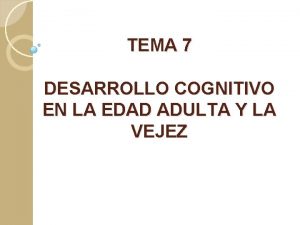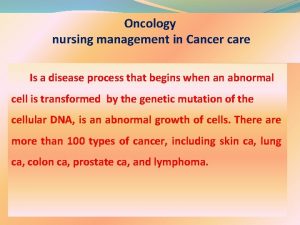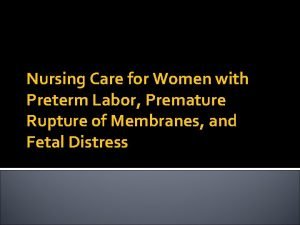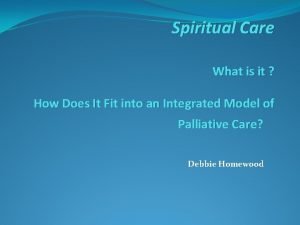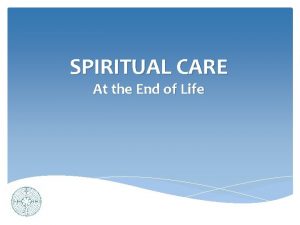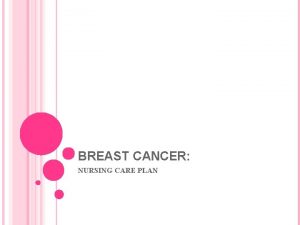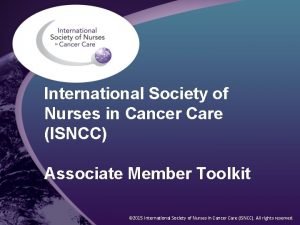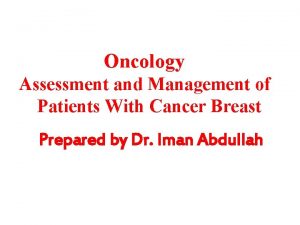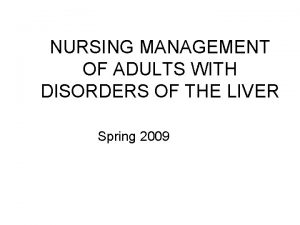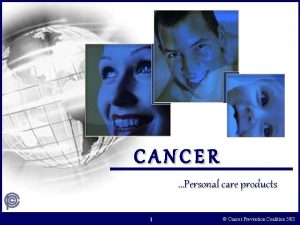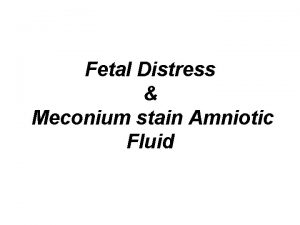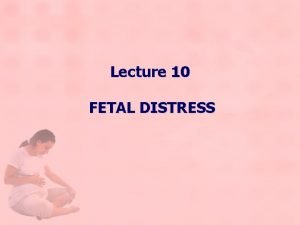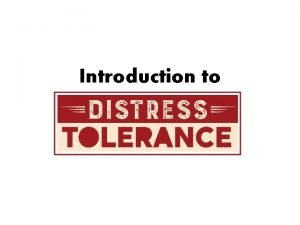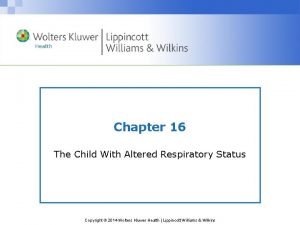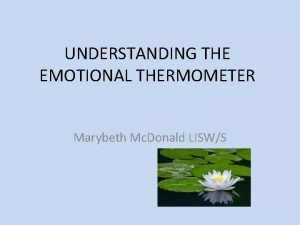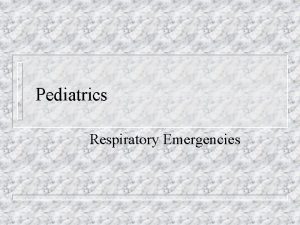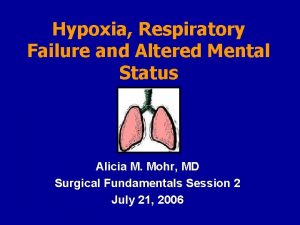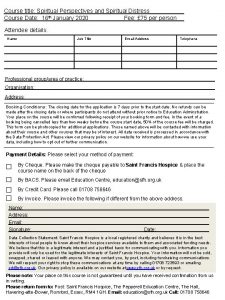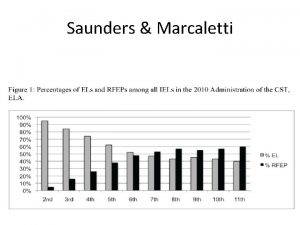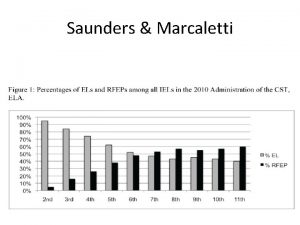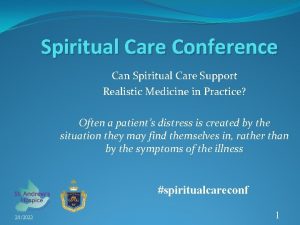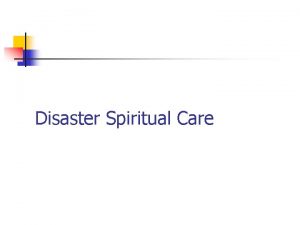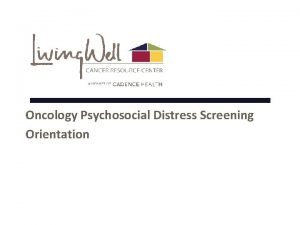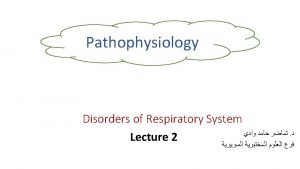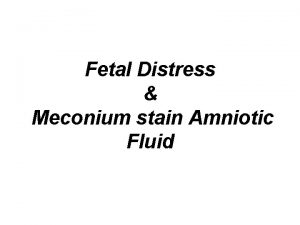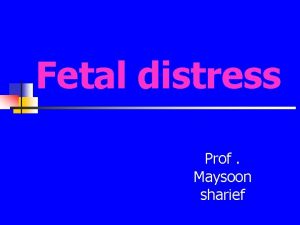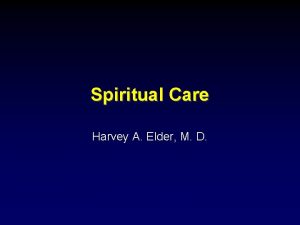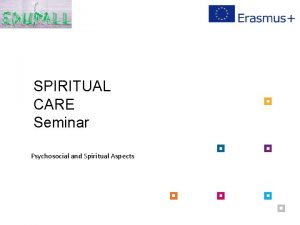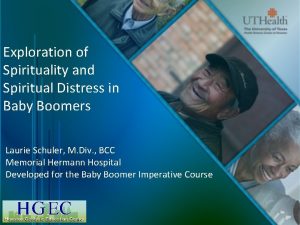Spiritual Distress Management in Cancer Care Linda Thompson












































- Slides: 44

Spiritual Distress Management in Cancer Care Linda Thompson, MA Chaplain, St. Joseph Mercy Hospital, Oakland Diane Kreslins, MPC, BCC Spiritual Care Coordinator, Mercy Health Lacks Cancer Center November 2014

Objectives • Define spirituality, spiritual health, and spiritual distress • Knowledge of distress management • Articulate what indicators may be signs of spiritual distress in oncology patients • Identify when and how to make referrals to chaplaincy services. • Application of spiritual distress screening Copyright 2013 Trinity Health - Livonia, Michigan

What is Spirituality? Spirituality is the aspect of humanity that refers to the way individuals seek and express meaning and purpose and the way they experience their connectedness to the moment, to self, to others, to nature, and to the significant or sacred. Christina Puchalski, M. D. , M. S. , F. A. P. C. , et. al. Improving the Quality of Spiritual Care as Dimension of Palliative Care: The Report of the Consensus Conference. Journal Of Palliative Medicine. Volume 12, Number 10, 2009. Copyright 2013 Trinity Health - Livonia, Michigan 3

Spirituality refers to the propensity to make meaning through a sense of relatedness to dimensions that transcend the self in such a way that empowers and does not devalue the individual. Reed, P. G. (1992) An emerging paradigm for the investigation of spirituality in nursing. Research in Nursing & Health, 15(5), 349 -357. Copyright 2013 Trinity Health - Livonia, Michigan 4

What is Religion? Religion can be viewed as a specific set of beliefs and practices associated with a recognized religion or denomination. Task force report: Spirituality, Cultural issues, and End-of-life Care. Association of American Medical Colleges. Report III. Contemporary Issues in Medicine: Communication in Medicine. Washington, D. C: Association of American Medical Colleges, 1999, pp. 24 -29. Copyright 2013 Trinity Health - Livonia, Michigan 5

Religion has specific behavioral, social, doctrinal and denominational characteristics because it involves a system of worship and doctrine that is shared within a group. Multidimensional Measurement of Religiousness / Spirituality for use in Health Research: A Report the Fetzer Institute / National Institute on Aging Working Group. Kalamazoo, MI: Fetzer Institute 2003 (1999). Copyright 2013 Trinity Health - Livonia, Michigan 6

Evidence of Spiritual Health • Meaning • Value • Transcendence • Connecting • Becoming Sanders, C. Challenges for spiritual care-giving in the millennium. Contemporary Nurse 2002 April; 12(2): 107 -11. Copyright 2013 Trinity Health - Livonia, Michigan 7

What is Distress? “Distress extends along a continuum, ranging from common normal feelings of vulnerability, sadness, and fears to problems that can become disabling, such as depression, anxiety, panic, social isolation, and existential and spiritual crisis. ” Referenced with permission from the NCCN Clinical Practice Guidelines in Oncology (NCCN Guidelines®) for Distress Management V. 2. 2013. © National Comprehensive Cancer Network, Inc 2013. All rights reserved. Accessed August 1, 2013. To view the most recent and complete version of the guideline, go online to www. nccn. org. NATIONAL COMPREHENSIVE CANCER NETWORK®, NCCN®, NCCN GUIDELINES®, and all other NCCN Content are trademarks owned by the National Comprehensive Cancer Network, Inc. Copyright 2013 Trinity Health - Livonia, Michigan 8

Most Common Spiritual Distresses • • • Grief Concerns about death and afterlife Conflicted or challenged belief systems Loss of faith Concerns with meaning/purpose of life Concerns about relationship with deity Isolation from religious community Guilt Hopelessness Conflict between religious beliefs and recommended treatments Ritual Needs Referenced with permission from the NCCN Clinical Practice Guidelines in Oncology (NCCN Guidelines®) for Distress Management V. 2. 2013. © National Comprehensive Cancer Network, Inc 2013. All rights reserved. Accessed August 1, 2013. To view the most recent and complete version of the guideline, go online to www. nccn. org. NATIONAL COMPREHENSIVE CANCER NETWORK®, NCCN GUIDELINES®, and all other NCCN Content are trademarks owned by the National Comprehensive Cancer Network, Inc. Copyright 2013 Trinity Health - Livonia, Michigan 9

Spiritual Assessment Examples Diagnoses (Primary) Key feature from history Example Statements Existential Lack of meaning / questions meaning about one’s own existence / Concern about afterlife / Questions the meaning of suffering / Seeks spiritual assistance “My life is meaningless” “I feel useless” Abandonment God or others lack of love, loneliness / Not being remembered / No Sense of Relatedness Anger at God or others Displaces anger toward religious representatives / Inability to Forgive Concerns about relationship with deity Closeness to God, deepening relationship Conflicted or challenged belief systems Verbalizes inner conflicts or questions about beliefs or faith Conflicts between religious beliefs and recommended treatments / Questions moral or ethical implications of therapeutic regimen / Express concern with life/death and/or belief system Despair / Hopelessness about future health, life Despair as absolute hopelessness, no hope for value in life Grief/loss Grief is the feeling and process associated with a loss of person, health, etc Guilt/shame Guilt is feeling that the person has done something wrong or evil; shame is a feeling that the person is bad or evil “I do not deserve to die pain-free” Reconciliation Need forgiveness and/or reconciliation of self or others I need to be forgiven for what I did I would like my wife to forgive me Isolation From religious community or other Religious specific Ritual needs / Unable to practice in usual religious practices Religious / Spiritual Struggle Loss of faith and/or meaning / Religious or spiritual beliefs and/or community not helping with coping “God has abandoned me” “No one comes by anymore” “Why would God take my child…its not fair” “I want to have a deeper relationship with God” “I am not sure if God is with me anymore” “Life is being cut short” “There is nothing left for me to live for” “I miss my loved one so much” “I wish I could run again” “Since moving to the assisted living I am not able to go to my church anymore” “I just can’t pray anymore” “What if all that I believe is not true” Christina Puchalski, M. D. , M. S. , F. A. P. C. , et. al. Improving the Quality of Spiritual Care as Dimension of Palliative Care: The Report of the Consensus Conference. Journal Of Palliative Medicine. Volume 12, Number 10, 2009 10

Spiritual Distress Screening Ron Copyright 2013 Trinity Health - Livonia, Michigan 11

Spiritual Distress Screening Ron is a 25 year-old male recently diagnosed with multiple myeloma. During a follow-up visit with his oncologist, while reviewing treatment options, Ron comments, “I just don’t know what to do anymore. ” Realizing Ron is probably feeling overwhelmed, he pauses and assures Ron that he has time to reflect with him about his choices. The oncologist and Ron agree on a chaplaincy services referral for moderate spiritual distress related to conflict between beliefs and treatment options. Chaplain Bob follows-up on the doctor’s referral. During the assessment, Ron shares with Bob that he is an avid runner and fears he will never be able to run again due to his cancer. Ron continues to tell Bob it is when he runs that he feels closest to God, and describes it as his “therapy. ” Copyright 2013 Trinity Health - Livonia, Michigan

Spiritual Distress Screening Ron • What was the oncologist’s clue that Ron may be experiencing spiritual distress? • How might Ron’s behavior display itself? • What spiritual distress issues would you identify? • Any surprises? Copyright 2013 Trinity Health - Livonia, Michigan 13

Outcomes of Spiritual /Religious Coping • • • ↓ anxiety, depression and discomfort ↓ isolation ↑ adjustment ↑ ability to enjoy life personal growth ↑ health outcomes National Cancer Institute: PDQ® Spirituality in Cancer Care 2012 Copyright 2013 Trinity Health - Livonia, Michigan 14

Clinical Impact of Spiritual and/or Religious Beliefs • Understanding of illness • Healthcare decision-making • Support / decision-maker • Treatment choices • Care plan • Coping Puchalski, CM. Psychiatric annals; March 2006; 36, 3 Psychology Module pg. 150. Copyright 2013 Trinity Health - Livonia, Michigan 15

Spiritual Care Part Two: § Fundamental component § Pastoral and spiritual responsibility Copyright 2013 Trinity Health - Livonia, Michigan 16

What is Spiritual Care? Interventions, individual or communal, that facilitate the ability to express the integration of the body, mind, and spirit to achieve wholeness, health, and a sense of connection to self, others, and[/or] a higher power. American Nurses Association, & Health Ministries Association. (2005). Faith and community nursing: Scope and standards of practice. Silver Spring, MD: American Nurses Association.

IDT Spiritual Care Interventions Christina Puchalski, M. D. , M. S. , F. A. P. C. , et. al. Improving the Quality of Spiritual Care as Dimension of Palliative Care: The Report of the Consensus Conference. Journal Of Palliative Medicine. Volume 12, Number 10, 2009. • Compassionate presence • Reflective listening/query about important life events • Support patient sources of spiritual strength • Open ended questions • Inquiry about spiritual beliefs, values and practices • Life review, listening to the patient’s story • Targeted spiritual intervention • Continued presence and follow up 18

Patient satisfaction results 73% of patients with cancer have reported spiritual needs • Patients whose spiritual needs were not met reported lower quality of care and lower satisfaction with their care Astrow, AB, et al. Is failure to meet spiritual needs associated with cancer patients’ perceptions of quality of care and their satisfaction with care? Journal of Clinical Oncology 2007 December 20; 25(36): 5753 -57. Copyright 2013 Trinity Health - Livonia, Michigan 19

National Comprehensive Cancer Network (NCCN) Guidelines on Spiritual Distress 1. To access the NCCN Guidelines for Distress Management V. 2. 2013 visit www. nccn. org 1. Create a login (no charge) 2. You then can access 1. National comprehensive Cancer Network 2. NCCN 3. NCCN Guidelines (find Distress Module here) 1. Go to support services 1. Click Distress Management Module 1. Offer the clinical guidelines and pathways for spiritual distress management in oncology 4. All other NCCN content is accessible too Copyright 2013 Trinity Health - Livonia, Michigan 20

Clinical Assessment • Primary Oncology Team o Oncologist o Nurse o Social work • Provide ongoing o Screening for spiritual distress o Spiritual history (faith beliefs, practices, community) Referenced with permission from the NCCN Clinical Practice Guidelines in Oncology (NCCN Guidelines®) for Distress Management V. 2. 2013. © National Comprehensive Cancer Network, Inc 2013. All rights reserved. Accessed August 1, 2013. To view the most recent and complete version of the guideline, go online to www. nccn. org. NATIONAL COMPREHENSIVE CANCER NETWORK®, NCCN GUIDELINES®, and all other NCCN Content are trademarks owned by the National Comprehensive Cancer Network, Inc. Copyright 2013 Trinity Health - Livonia, Michigan

Distress Thermometer Screening Tool Reproduced with permission from the NCCN Clinical Practice Guidelines in Oncology (NCCN Guidelines®) for Distress Management V. 2. 2013. © 2013 National Comprehensive Cancer Network, Inc. All rights reserved. The NCCN Guidelines® and illustrations herein may not be reproduced in any form for any purpose without the express written permission of the NCCN. To view the most recent and complete version of the NCCN Guidelines, go online to NCCN. org. NATIONAL COMPREHENSIVE CANCER NETWORK®, NCCN GUIDELINES®, and all other NCCN Content are trademarks owned by the National Comprehensive Cancer Network, Inc. Copyright 2013 Trinity Health - Livonia, Michigan

Spiritual Distress Screening Tool: What is the pt. verbalizing? Grief Concerns about death and afterlife Ritual needs Conflicted or challenged belief systems Conflict between religious belief & recommended treatment Voicing Hopeless- Loss of faith ness Concerns with meaning/ Guilt purpose of life Isolation from religious community • • Concerns about relation-ship with deity If above moderate to high : distress is addressed by chaplaincy services If mild to moderate: distress addressed by clinical oncology team Referenced with permission from the NCCN Clinical Practice Guidelines in Oncology (NCCN Guidelines®) for Distress Management V. 2. 2013. © National Comprehensive Cancer Network, Inc 2013. All rights reserved. Accessed August 1, 2013. To view the most recent and complete version of the guideline, go online to www. nccn. org. NATIONAL COMPREHENSIVE CANCER NETWORK®, NCCN GUIDELINES®, and all other NCCN Content are trademarks owned by the National Comprehensive Cancer Network, Inc. Copyright 2013 Trinity Health - Livonia, Michigan

Most Common Spiritual Distresses • • • Grief Concerns about death and afterlife Conflicted or challenged belief systems Loss of faith Concerns with meaning/purpose of life Concerns about relationship with deity Isolation from religious community Guilt Hopelessness Conflict between religious beliefs and recommended treatments Ritual Needs Referenced with permission from the NCCN Clinical Practice Guidelines in Oncology (NCCN Guidelines®) for Distress Management V. 2. 2013. © National Comprehensive Cancer Network, Inc 2013. All rights reserved. Accessed August 1, 2013. To view the most recent and complete version of the guideline, go online to www. nccn. org. NATIONAL COMPREHENSIVE CANCER NETWORK®, NCCN GUIDELINES®, and all other NCCN Content are trademarks owned by the National Comprehensive Cancer Network, Inc. Copyright 2013 Trinity Health - Livonia, Michigan 24

Spiritual Assessment Examples Diagnoses (Primary) Key feature from history Example Statements Existential Lack of meaning / questions meaning about one’s own existence / Concern about afterlife / Questions the meaning of suffering / Seeks spiritual assistance “My life is meaningless” “I feel useless” Abandonment God or others lack of love, loneliness / Not being remembered / No Sense of Relatedness Anger at God or others Displaces anger toward religious representatives / Inability to Forgive Concerns about relationship with deity Closeness to God, deepening relationship Conflicted or challenged belief systems Verbalizes inner conflicts or questions about beliefs or faith Conflicts between religious beliefs and recommended treatments / Questions moral or ethical implications of therapeutic regimen / Express concern with life/death and/or belief system Despair / Hopelessness about future health, life Despair as absolute hopelessness, no hope for value in life Grief/loss Grief is the feeling and process associated with a loss of person, health, etc Guilt/shame Guilt is feeling that the person has done something wrong or evil; shame is a feeling that the person is bad or evil “I do not deserve to die pain-free” Reconciliation Need forgiveness and/or reconciliation of self or others I need to be forgiven for what I did I would like my wife to forgive me Isolation From religious community or other Religious specific Ritual needs / Unable to practice in usual religious practices Religious / Spiritual Struggle Loss of faith and/or meaning / Religious or spiritual beliefs and/or community not helping with coping “God has abandoned me” “No one comes by anymore” “Why would God take my child…its not fair” “I want to have a deeper relationship with God” “I am not sure if God is with me anymore” “Life is being cut short” “There is nothing left for me to live for” “I miss my loved one so much” “I wish I could run again” “Since moving to the assisted living I am not able to go to my church anymore” “I just can’t pray anymore” “What if all that I believe is not true” Christina Puchalski, M. D. , M. S. , F. A. P. C. , et. al. Improving the Quality of Spiritual Care as Dimension of Palliative Care: The Report of the Consensus Conference. Journal Of Palliative Medicine. Volume 12, Number 10, 2009 25

Distress Thermometer • What is their “distress” temperature? • The number the pt. rates it on a scale of 0 – 10, with 10 the highest • What may a 6 -10 rate sound and look like? Copyright 2013 Trinity Health - Livonia, Michigan 26

Spiritual Distress – What to Listen For What spiritual distress issues do you hear: • “Why is this happening to me? ” • “What do I have to look forward to now? ” • “If I stop treatment, isn’t that considered suicide? ” • “What’s the use? ” • “I miss the church I used to go to. ” Copyright 2013 Trinity Health - Livonia, Michigan 27

Spiritual Distress – What to Listen For What spiritual distress issues do you hear: • “I used to have a Rabbi that I liked, but she relocated out of state. ” • “This is how my father died. ” • “My prayers were good for nothing – I still got sick. ” • “Just don’t let me die, Doctor. ” Copyright 2013 Trinity Health - Livonia, Michigan 28

Spiritual Distress – What to Look For • Changes in patient’s mood or behavior • Exaggerated focus on mortality, preparing for death • Concerns for legacy-leaving • Desire for personal story-telling • Meaning-making conversations, searching for purposeful activities • What else? Copyright 2013 Trinity Health - Livonia, Michigan 29

Coordination of Care for Spiritual Distress • Clinical team • • Screens for spiritual distress at each patient visit Manages low to medium levels of spiritual distress through resources and within one’s scope of practice Refers patient to chaplaincy services for medium to high levels of spiritual distress Chaplain • • Manages medium to high levels of spiritual distress Member of the care team • Script preferred: “I believe you would benefit by seeing our chaplain. We provide a chaplain on our team to assist with spiritual distress. ” • Not “Would you like to see a chaplain? ” Provides spiritual assessment Informs clinical team of outcome and plan of care in EMR Referenced with permission from the NCCN Clinical Practice Guidelines in Oncology (NCCN Guidelines®) for Distress Management V. 2. 2013. © National Comprehensive Cancer Network, Inc 2013. All rights reserved. Accessed August 1, 2013. To view the most recent and complete version of the guideline, go online to www. nccn. org. NATIONAL COMPREHENSIVE CANCER NETWORK®, NCCN GUIDELINES®, and all other NCCN Content are trademarks owned by the National Comprehensive Cancer Network, Inc. Copyright 2013 Trinity Health - Livonia, Michigan

When to Refer to a Chaplain for Spiritual Distress Examples of Spiritual Distress Diagnoses* If Mild to Moderate Distress If above Moderate Distress Grief (DIS-22) Addressed by Health Care Provider Addressed by Chaplaincy Services Concerns about death and afterlife (DIS-22) Addressed by Health Care Provider Addressed by Chaplaincy Services Conflicted or challenged belief systems (DIS-22) Addressed by Health Care Provider Addressed by Chaplaincy Services Loss of faith (DIS-22) Addressed by Health Care Provider Addressed by Chaplaincy Services Concerns with meaning/purpose of life (DIS-22) Addressed by Health Care Provider Addressed by Chaplaincy Services Concerns about relationship with deity (DIS-22) Addressed by Health Care Provider Addressed by Chaplaincy Services Isolation from religious community (DIS-23) Addressed by Health Care Provider Addressed by Chaplaincy Services Guilt (DIS-24) Addressed by Health Care Provider Addressed by Chaplaincy Services Addressed by Health Care Addressed by Chaplaincy Hopelessness (DIS-25) * Referenced with permission from the NCCN Clinical Practice Guidelines in Oncology (NCCN Guidelines®) for Distress Provider Services Management V. 2. 2013. © National Comprehensive Cancer Network, Inc 2013. All rights reserved. Accessed August 1, 2013. To view the most recent and complete version of the guideline, go online to www. nccn. org. NATIONAL Conflict between religious beliefs and recommended Addressed by Health Care Addressed by Chaplaincy COMPREHENSIVE CANCER NETWORK®, NCCN GUIDELINES®, and all other NCCN Content are trademarks owned by the treatments (DIS-26) Provider Services National Comprehensive Cancer Network, Inc. Ritual needs (DIS-27) Addressed by Health Care Provider Addressed by Chaplaincy Services 32

Consult/Refer to Chaplaincy Services When patient and/or family • • • Verbalizing moderate to high levels of spiritual distress Requesting spiritual/religious support Need is spiritual and religious in nature Referenced with permission from the NCCN Clinical Practice Guidelines in Oncology (NCCN Guidelines®) for Distress Management V. 2. 2013. © National Comprehensive Cancer Network, Inc 2013. All rights reserved. Accessed August 1, 2013. To view the most recent and complete version of the guideline, go online to www. nccn. org. NATIONAL COMPREHENSIVE CANCER NETWORK®, NCCN GUIDELINES®, and all other NCCN Content are trademarks owned by the National Comprehensive Cancer Network, Inc. Copyright 2013 Trinity Health - Livonia, Michigan 33

Reproduced with permission from the NCCN Clinical Practice Guidelines in Oncology (NCCN Guidelines®) for Distress Management V. 2. 2013. © 2013 National Comprehensive Cancer Network, Inc. All rights reserved. The NCCN Guidelines® and illustrations herein may not be reproduced in any form for any purpose without the express written permission of the NCCN. To view the most recent and complete version of the NCCN Guidelines, go online to NCCN. org. NATIONAL COMPREHENSIVE CANCER NETWORK®, NCCN GUIDELINES®, and all other NCCN Content are trademarks owned by the National Comprehensive Cancer Network, Inc. Copyright 2013 Trinity Health - Livonia, Michigan 34

Reproduced with permission from the NCCN Clinical Practice Guidelines in Oncology (NCCN Guidelines®) for Distress Management V. 2. 2013. © 2013 National Comprehensive Cancer Network, Inc. All rights reserved. The NCCN Guidelines® and illustrations herein may not be reproduced in any form for any purpose without the express written permission of the NCCN. To view the most recent and complete version of the NCCN Guidelines, go online to NCCN. org. NATIONAL COMPREHENSIVE CANCER NETWORK®, NCCN GUIDELINES®, and all other NCCN Content are trademarks owned by the National Comprehensive Cancer Network, Inc. 35

Chaplaincy Services Part of psychosocial services “Patients who experience guilt or hopelessness should also be evaluated by mental health professionals for further assessment since they may also have severe depressive symptoms or suicidal ideations. ” Referenced with permission from the NCCN Clinical Practice Guidelines in Oncology (NCCN Guidelines®) for Distress Management V. 2. 2013. © National Comprehensive Cancer Network, Inc 2013. All rights reserved. Accessed August 1, 2013. To view the most recent and complete version of the guideline, go online to www. nccn. org. NATIONAL COMPREHENSIVE CANCER NETWORK®, NCCN GUIDELINES®, and all other NCCN Content are trademarks owned by the National Comprehensive Cancer Network, Inc. Copyright 2013 Trinity Health - Livonia, Michigan

Spiritual Care Resources Mercy Cancer Network

SC Resources Library • Books, CDs, DVDs, diverse religious resources, sacred texts, hand labyrinths, bibles, meditation books, etc Website Chapel Services Others…

Community SC Resources • Patient’s religious leaders & community • Stephens Ministry, Be Friender Ministry, Prayer Lines, Food Pantry, financial support, pastoral counseling; rituals of healing, parish nurses, etc. • Gilda’s Club: classes of spiritual support • Internet Websites: Dave Dravecky, ACS, etc. • Retreat Centers • Retreats, Centering Prayer, Spiritual Direction, Spiritual Companions, Labyrinth Classes, Meditation Classes, Journaling Classes • Others…

Spiritual Distress Screening Julie Copyright 2013 Trinity Health - Livonia, Michigan 40

Spiritual Distress Screening Julie is a 43 year-old female diagnosed with breast cancer. She has gone through surgery and is currently receiving outpatient chemotherapy. Since her surgery, she seems more emotionally withdrawn than usual (i. e. more quiet, not engaging in conversation, little eye contact, mood appears to be down). Thinking the patient is having a grief reaction, the nurse has referred the patient to a social worker for counseling. The social worker follows-up with the patient and agrees with the nurse’s assessment that the patient is experiencing grief and loss. The social worker refers Julie to the chaplain services to provide additional support. During the chaplain’s assessment, Julie shares the fact that her older sister was also diagnosed with breast cancer, and she had died 3 years ago. Julie recalls encouraging her sister to “fight the disease” and to overcome her symptoms. Now that Julie is experiencing the cancer symptoms personally, she realizes her approach with her sister may not have been helpful, and she feels guilty. Copyright 2013 Trinity Health - Livonia, Michigan 41

Spiritual Distress Screening Julie • What were the indicators that Julie may be experiencing spiritual distress? • What spiritual distress is Julie experiencing? • Were there any surprises for you? • Have you seen “Julie” in your clinical practice? What does this patient look like? Copyright 2013 Trinity Health - Livonia, Michigan 42

A Mutual Journey of Care and Growth “When people are overwhelmed by illness, we must give them physical relief, but it is equally important to encourage the spirit through a constant show of love and compassion. It is shameful how often we fail to see that what people desperately require is human affection. Deprived of human warmth and a sense of value, other forms of treatment prove less effective. Real care of the sick does not begin with costly procedures, but with the simple gifts of affection, love, and concern. ” His Holiness, The Dalai Lama in A Time for Listening and Caring: Spirituality and the Care of the Chronically Ill and Dying by Christina M. Puchalski © 2006 Oxford University Press. . Copyright 2013 Trinity Health - Livonia, Michigan 43

Questions or Comments? Copyright 2013 Trinity Health - Livonia, Michigan 44

Evaluation Copyright 2013 Trinity Health - Livonia, Michigan 45
 Thompson y thompson
Thompson y thompson 1 corinthians 2:9-13
1 corinthians 2:9-13 Mylosuppresion
Mylosuppresion Nursing responsibility of tocolytics
Nursing responsibility of tocolytics Primary secondary and tertiary health care
Primary secondary and tertiary health care What is spiritual care
What is spiritual care What is spiritual care
What is spiritual care Care plan of breast cancer
Care plan of breast cancer Andrew dimech
Andrew dimech Physical assessment
Physical assessment Nursing management of liver abscess
Nursing management of liver abscess Personal care products and cancer risk
Personal care products and cancer risk What is quadrant 2
What is quadrant 2 Paragraph about stress
Paragraph about stress Pearlin theory
Pearlin theory Leonard pearlin theory of psychological distress
Leonard pearlin theory of psychological distress Meconium grade 1 2 3
Meconium grade 1 2 3 Archetype damsel in distress
Archetype damsel in distress The temptress archetype examples
The temptress archetype examples Psychology, mental health and distress
Psychology, mental health and distress Distress
Distress Distress signal x1
Distress signal x1 Fetal distress definition
Fetal distress definition Verbalisasi distress adalah
Verbalisasi distress adalah Distress tolerance thermometer
Distress tolerance thermometer Respiratory distress
Respiratory distress Example of eustress
Example of eustress Arti psikologi klinis
Arti psikologi klinis Direct costs of financial distress
Direct costs of financial distress Emotional thermometer
Emotional thermometer Dbt stop skill video
Dbt stop skill video Eustress examples for students
Eustress examples for students Eustress
Eustress Contoh distress
Contoh distress Respiratory distress
Respiratory distress Moral distress and burnout
Moral distress and burnout Featal distress
Featal distress Respiratory distress nasal flaring
Respiratory distress nasal flaring Navarea viii warnings
Navarea viii warnings Static theory of capital structure
Static theory of capital structure T3 thyrotoxicosis causes
T3 thyrotoxicosis causes Euthyroid hashimoto's
Euthyroid hashimoto's Standard 3 care certificate
Standard 3 care certificate Este fenomenul prin care corpurile care contin fier
Este fenomenul prin care corpurile care contin fier Palliative care vs hospice care
Palliative care vs hospice care
